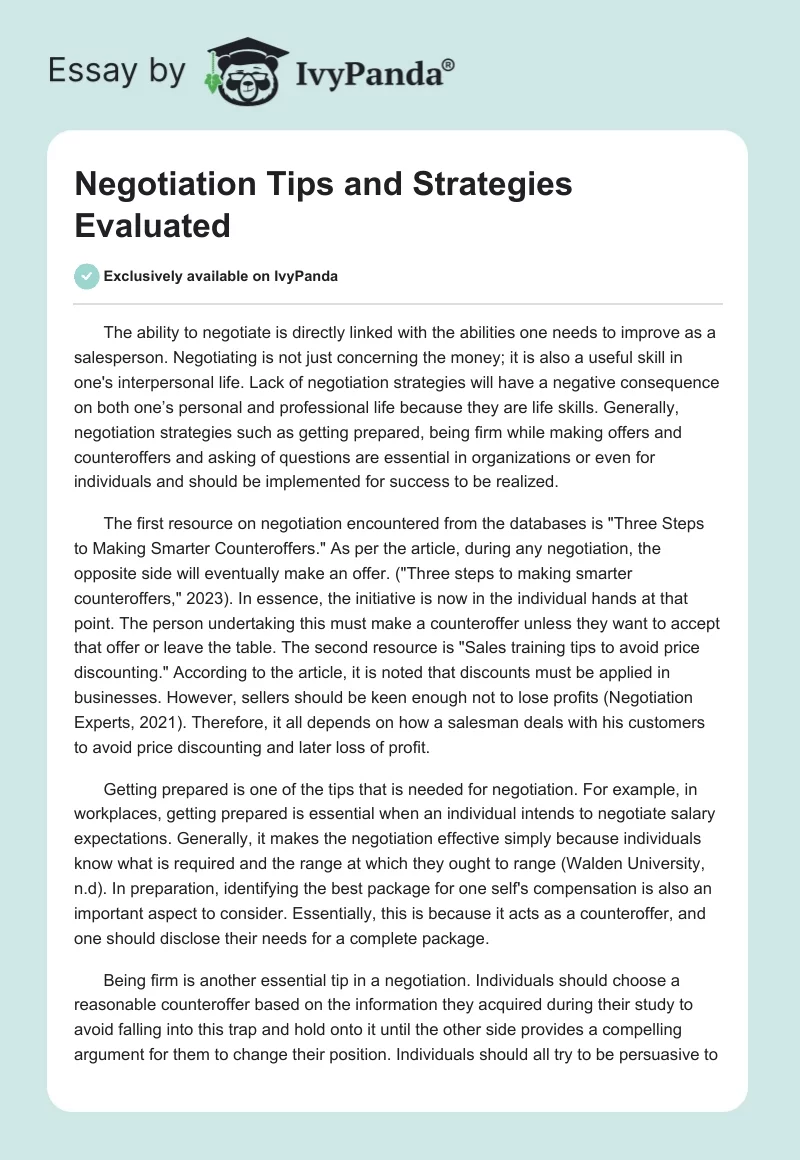The ability to negotiate is directly linked with the abilities one needs to improve as a salesperson. Negotiating is not just concerning the money; it is also a useful skill in one’s interpersonal life. Lack of negotiation strategies will have a negative consequence on both one’s personal and professional life because they are life skills. Generally, negotiation strategies such as getting prepared, being firm while making offers and counteroffers and asking of questions are essential in organizations or even for individuals and should be implemented for success to be realized.
The first resource on negotiation encountered from the databases is “Three Steps to Making Smarter Counteroffers.” As per the article, during any negotiation, the opposite side will eventually make an offer. (“Three steps to making smarter counteroffers,” 2023). In essence, the initiative is now in the individual hands at that point. The person undertaking this must make a counteroffer unless they want to accept that offer or leave the table. The second resource is “Sales training tips to avoid price discounting.” According to the article, it is noted that discounts must be applied in businesses. However, sellers should be keen enough not to lose profits (Negotiation Experts, 2021). Therefore, it all depends on how a salesman deals with his customers to avoid price discounting and later loss of profit.
Getting prepared is one of the tips that is needed for negotiation. For example, in workplaces, getting prepared is essential when an individual intends to negotiate salary expectations. Generally, it makes the negotiation effective simply because individuals know what is required and the range at which they ought to range (Walden University, n.d). In preparation, identifying the best package for one self’s compensation is also an important aspect to consider. Essentially, this is because it acts as a counteroffer, and one should disclose their needs for a complete package.
Being firm is another essential tip in a negotiation. Individuals should choose a reasonable counteroffer based on the information they acquired during their study to avoid falling into this trap and hold onto it until the other side provides a compelling argument for them to change their position. Individuals should all try to be persuasive to enhance a reasonable negotiation (Shonk, 2022). By “persuasive,” generally, it means a justification for a different figure or package than they had produced based on new information or data. An employer might, for example, state that he is aware that some of his rivals are providing bigger compensation ranges. But because they are a lot bigger than they are, they require them to spend much more time working for a bigger clientele. Individuals provide pay that enables one to lead a respectable professional life and significantly influence smaller businesses.
The third tip or skill referred to in the source is asking as many questions as possible. In essence, this is a good strategy in negotiation since one can ask questions to determine the customer’s area of interest. Essentially, it helps determine many strategies that are to be implemented, like the timing of a deal and how the deal benefits the company. Therefore, by finding a solution to the asked questions, one can scale at a higher margin when the strategies are implemented well. Generally, this helps in determining what is needed in the firm and how beneficial it will be. Therefore, asking questions is beneficial for strategic negotiators.
In summary, organizations and individuals should use negotiation strategies such as being prepared, being firm and asking questions while making offers and counteroffers in order to succeed. They help run projects and also have a good scale bar of development in those deals. This article has just highlighted three skills that are vital in negotiation. That is, getting prepared, being firm, and lastly, buying the customer’s pain and, after a good evaluation, selling it. Therefore, for the success of any firm, negotiation strategies are elements to be implemented.
References
Negotiation Experts. (2021). Sales training tips to avoid price discounting. Negotiation Skills Workshops | Negotiation Experts. Web.
Shonk, K. (2022). Top 10 negotiation skills you must learn to succeed. PON – Program on Negotiation at Harvard Law School. Web.
Three steps to making smarter counteroffers. (2023). Military.com. Web.
Walden University. (n.d.). Ten-dos-and-donts-of-business-negotiating. Web.


